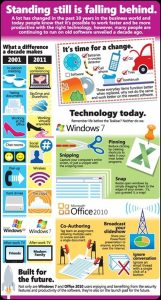As I noted in a prior post, Samoa will move their time zone this week, essentially traveling to the future…
When is December 30th not December 30th?
When it’s 2011 in Samoa.
[rimshot]
As you may have read, Samoa has decided to move ahead in time and join neighbors and trading partners on the western side of the International Date line (like Australia and New Zealand). In doing so, Samoa will move from December 29th directly to December 31st this year. As Alan Boyle wrote this week in his post on MSN…
“Just this once, Samoa is making Dec. 30 disappear.
“It’s the key step in the Pacific island nation’s plan to move from the eastern to the western side of the International Date Line and mesh its work week with two of its primary trading partners, New Zealand and Australia. The New Zealand territory of Tokelau is making the switch as well.
“In doing business with New Zealand and Australia, we’re losing out on two working days a week,” Stuff.co.nz quoted Samoan Prime Minister Tuila’epa Sailele as saying. “While it’s Friday here, it’s Saturday in New Zealand, and when we’re at church Sunday, they’re already conducting business in Sydney and Brisbane.”
“Samoa will go directly from 11:59 p.m. Thursday, through midnight to 12:01 a.m. Saturday.
“It hasn’t been controversial,” the editor of the Samoa Observer, Mata’afa Lesa, told me today. (Yes, definitely still today.) “People are realizing when they sleep tomorrow night, they’ll wake up on Saturday.”
Not contraversial? I’m not so sure, but that’s not a matter for this post. Just ask people who will miss a birthday (perhaps they won’t age a year?) or a special anniversary.
Technical Changes
The change will be a move from from UTC -11:00 to UTC+13:00, and a change in the display name for UTC +13:00 time zone (Nuku’alofa, Samoa). So, on the next clock tick after Dec 29, 2011 at 23:59:59, Samoa’s UTC offset becomes UTC +13:00. And the next clock tick will be is Dec 31, 2011 00:00:000. Cartographers will have some challenges dealing with all the updates to maps, moving the International Date Line to 171 degrees longitude west of Greenwich.
Associated challenges
There are also other technical challenges as I called out last year… as this change again occurs at midnite, but this time with good reason…
Here’s my regular advice for governments: in support of these types of changes, we provide guidance and Microsoft’s Policy in Response to DST/TZ Requests. It’s important for countries and territories to work towards seamless transitions to new DST and time zones policies, providing ample advance notice (of a year or more) with published confirmation of planned changes.
In addition – and this is important – we suggest that entities considering moves to DST implement changes at the next clock tick after 01:59:59 rather than at 00:00:00. Making the change at midnight can impact daily scheduled system events that sometimes occur at 12:00 midnite, such as back ups, data pulls or other automated tasks.
But I imagine that in Samoa’s case with this change, it would have been a greater challenge to have December 30th last only a few hours. Noting the article cites “there were 767 births and 43 marriages registered” on December 30th, I sympathize for the loss of a special day.
What’s Microsoft doing about this change?
Microsoft is aware of the upcoming change in time zone and shift in date for Samoa, and we’re looking at ways to minimize the impact this change has on our customers and partners. As with other changes to daylight saving time and time zones (like the recent change in Russia, noted here), this requires an update to the OS.
So users should look at the December 2011 cumulative time zone update for Windows operating systems avilable at http://support.microsoft.com/kb/2633952.
In addition to the change to the UTC offset for Samoa standard time from (UTC-11) to (UTC+13) — which will change the time zone’s display name to “(UTC+13:00) Samoa” — we also made additional changes since the last semi-annual Windows cumulative time zone update (back in August):
- Kaliningrad Standard Time:
As previously announced in Microsoft Knowledge Base article 2625508, Belarus has decided to discontinue daylight saving time from 2011 and stay on permanent “summer time.” That article suggested that users move to a “workaround time” of Kaliningrad standard time. This windows update makes the move permanent by including Minsk in the display name for Kaliningrad standard time. The new display name for Kaliningrad standard time is “(UTC+03:00) Kaliningrad, Minsk.” - E.Europe Standard Time:
The display name for this time zone has been updated to “(UTC+2:00) Nicosia.” - Bahia Standard Time [Display Name “(UTC-3:00) Salvador”]:
A new windows time zone has been created for the Brazilian state of Bahia. - Fiji Standard Time [Display Name “(UTC+12:00) Fiji”]:
Sets the 2012 DST start date to occur on the fourth Sunday of January.
Most applications and services reference the underlying Windows OS for their TZ and DST rules, with some exceptions. This change in Samoa has the potential for worldwide impacts on time references for multinational customers. Updates will be important not only for users in Samoa but for connected systems around the world, particularly Samoa’s closest partners in the region. Additional information is also available on our official Daylight Saving Time Help and Support Centre at http://www.microsoft.com/time.
So happy new year! Take comfort that at least Samoa decided not to skip that holiday. 😉
Tags: Microsoft, Daylight Saving Time, Daylight Savings Time, RSS, DST, Samoa
Also available via http://bit.ly/uTbcqT and https://t.co/5Nr3hWJR
